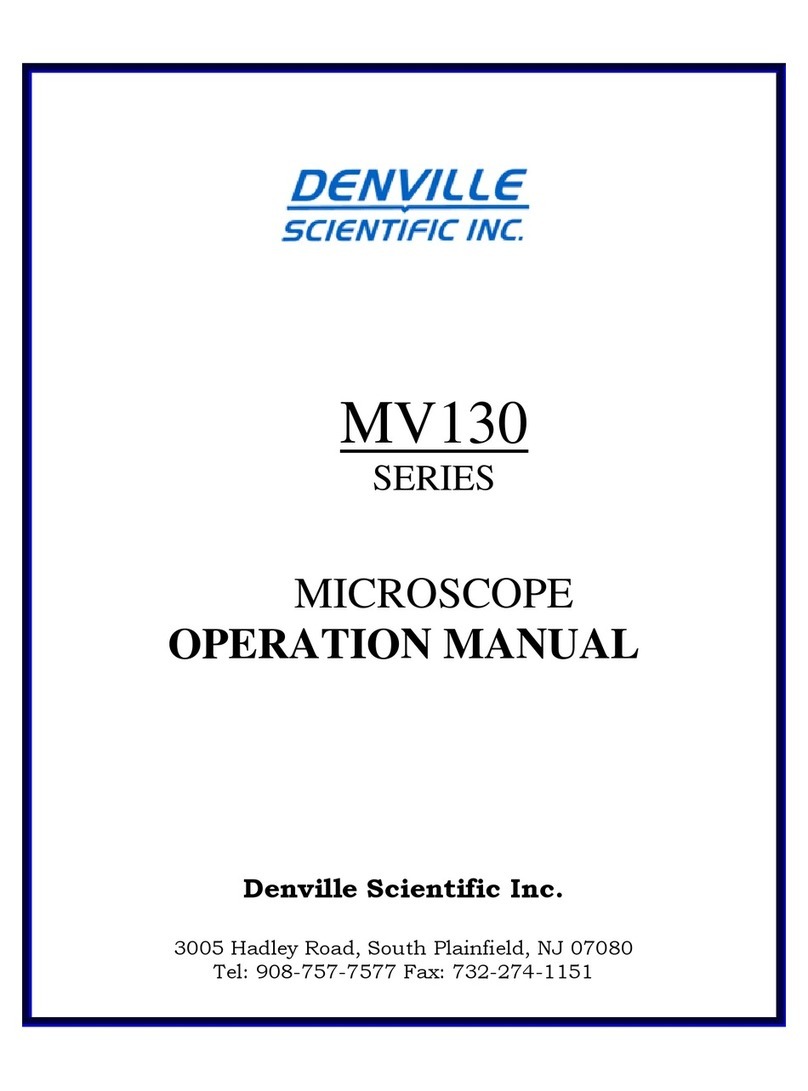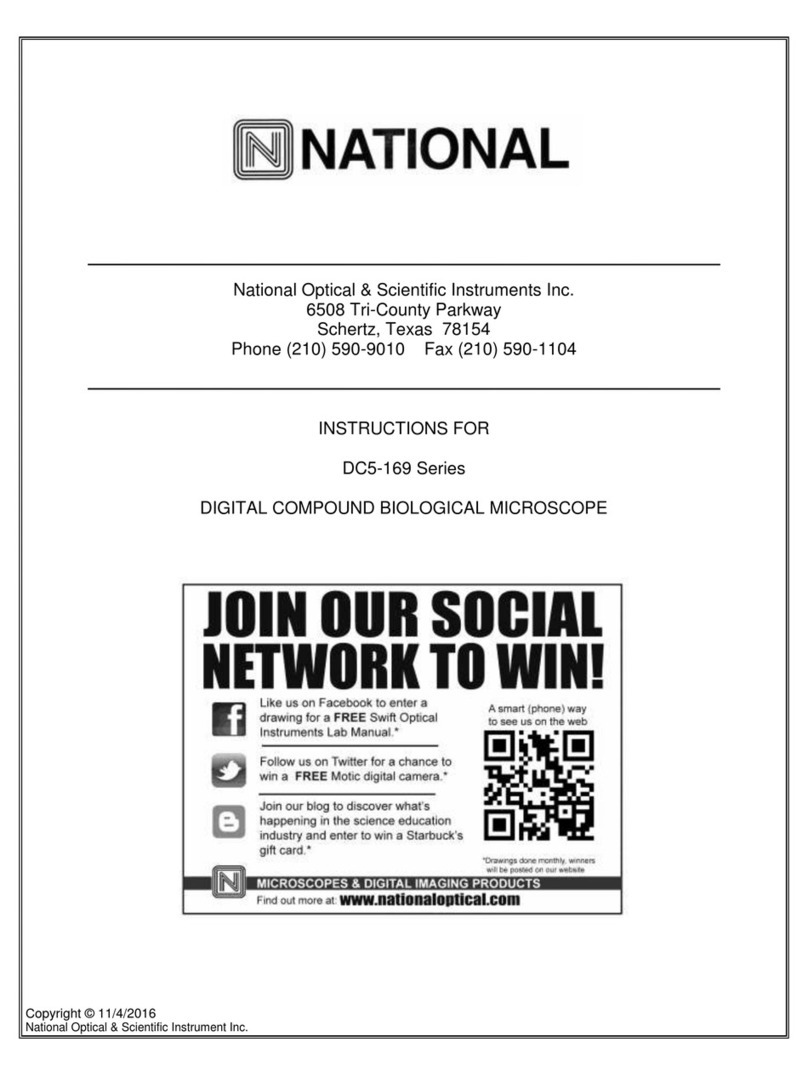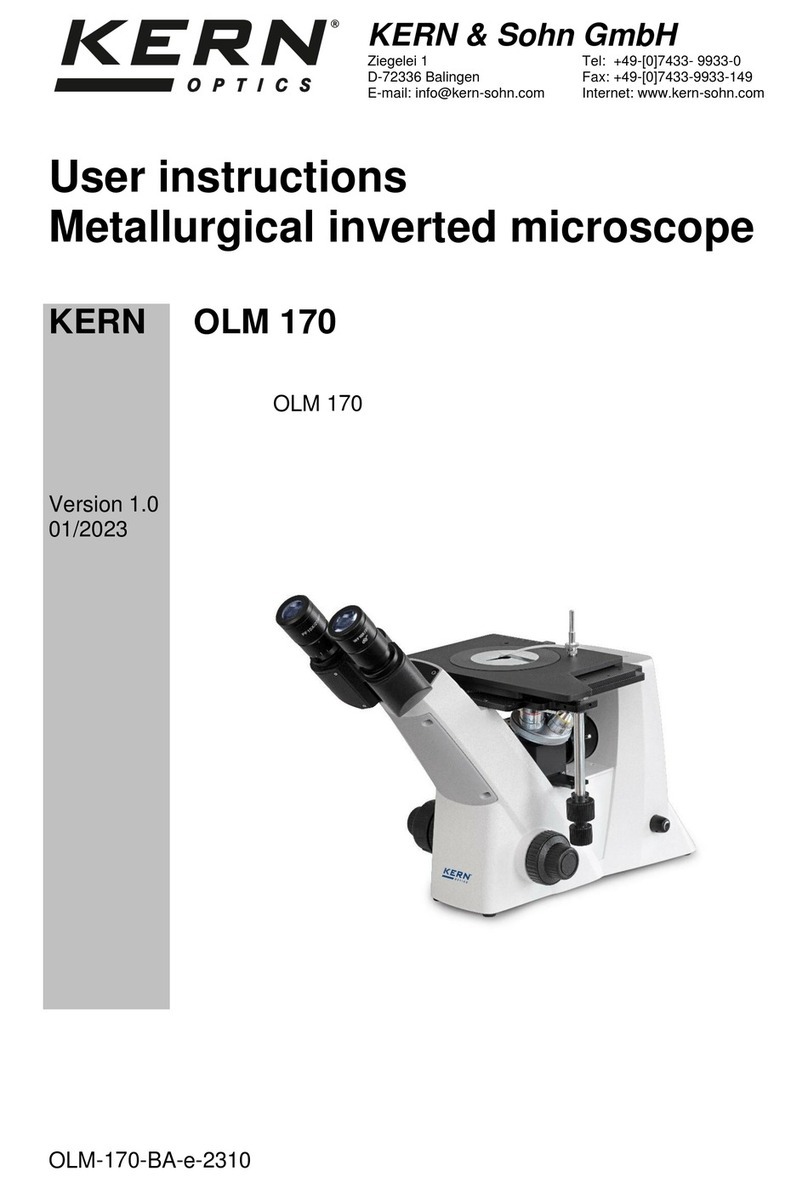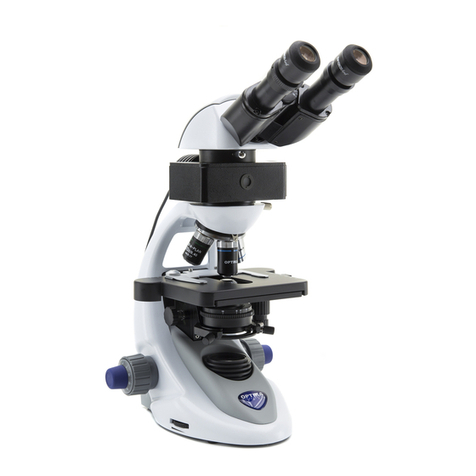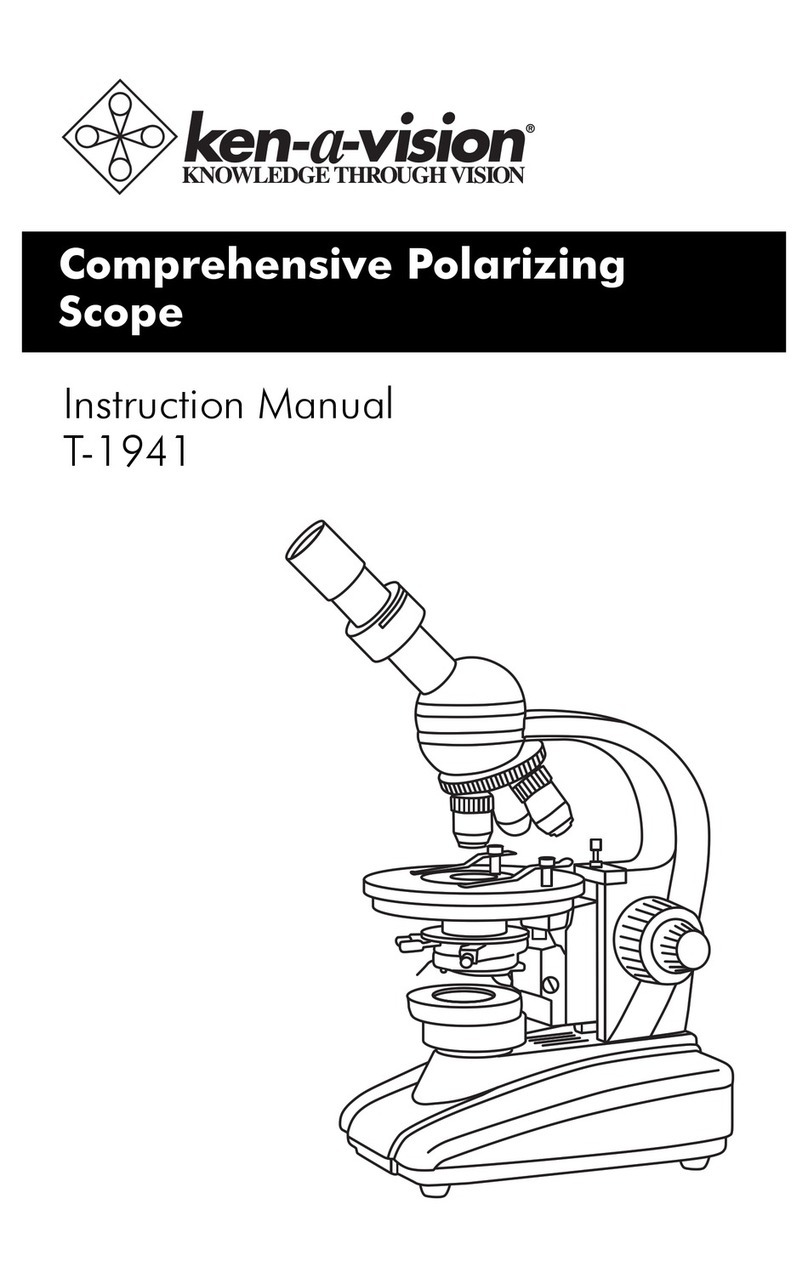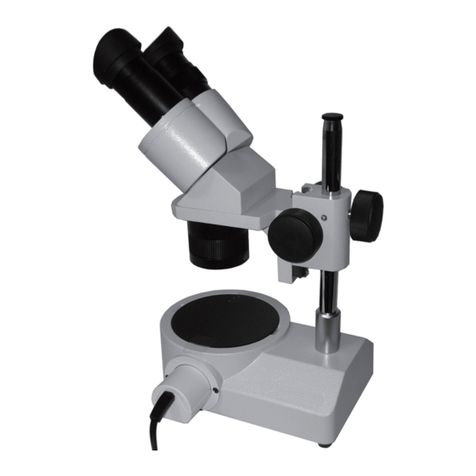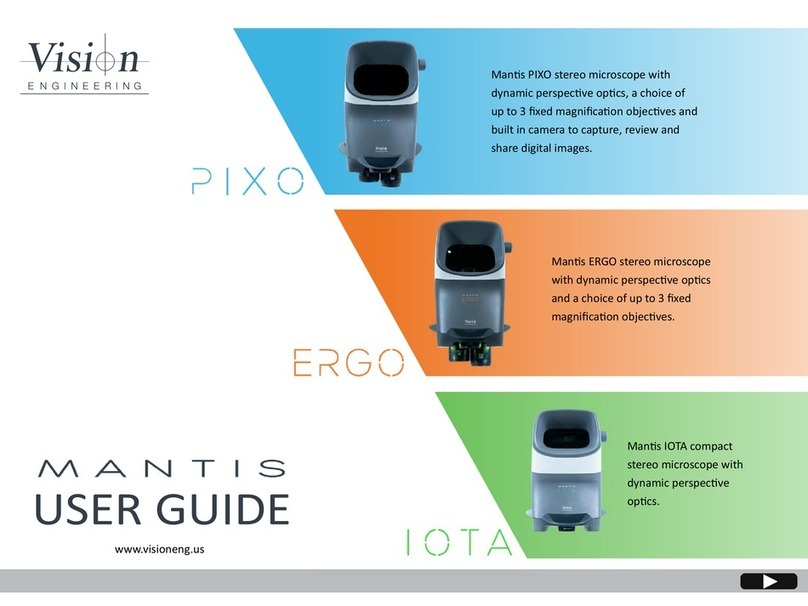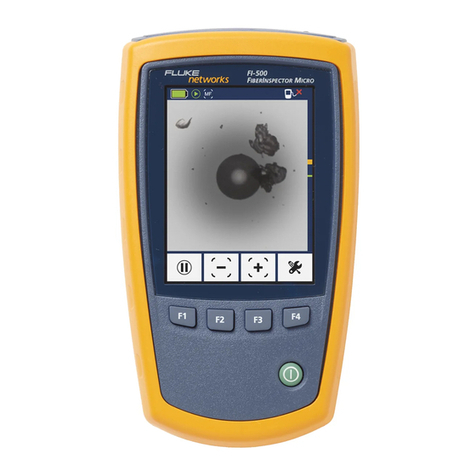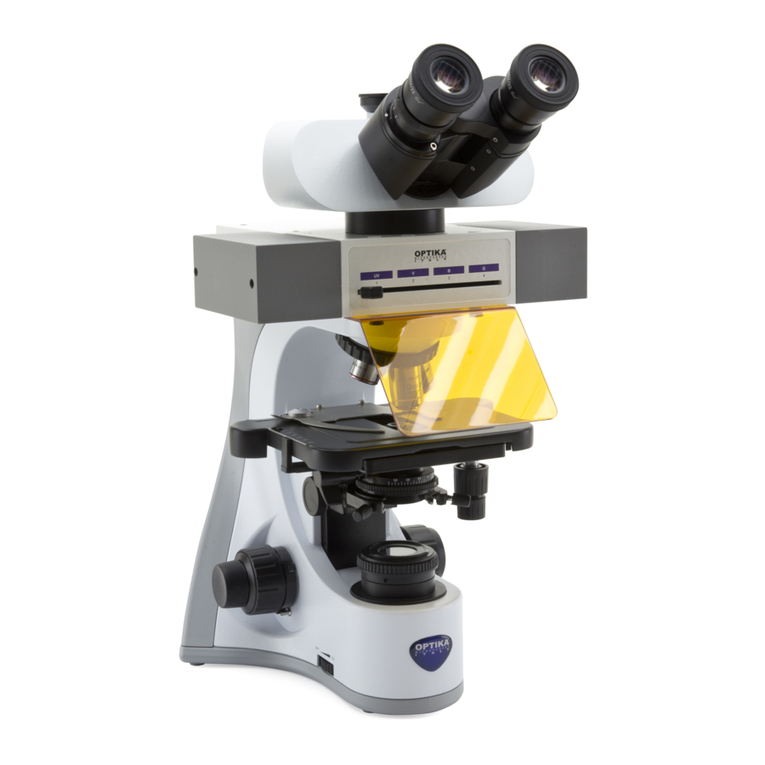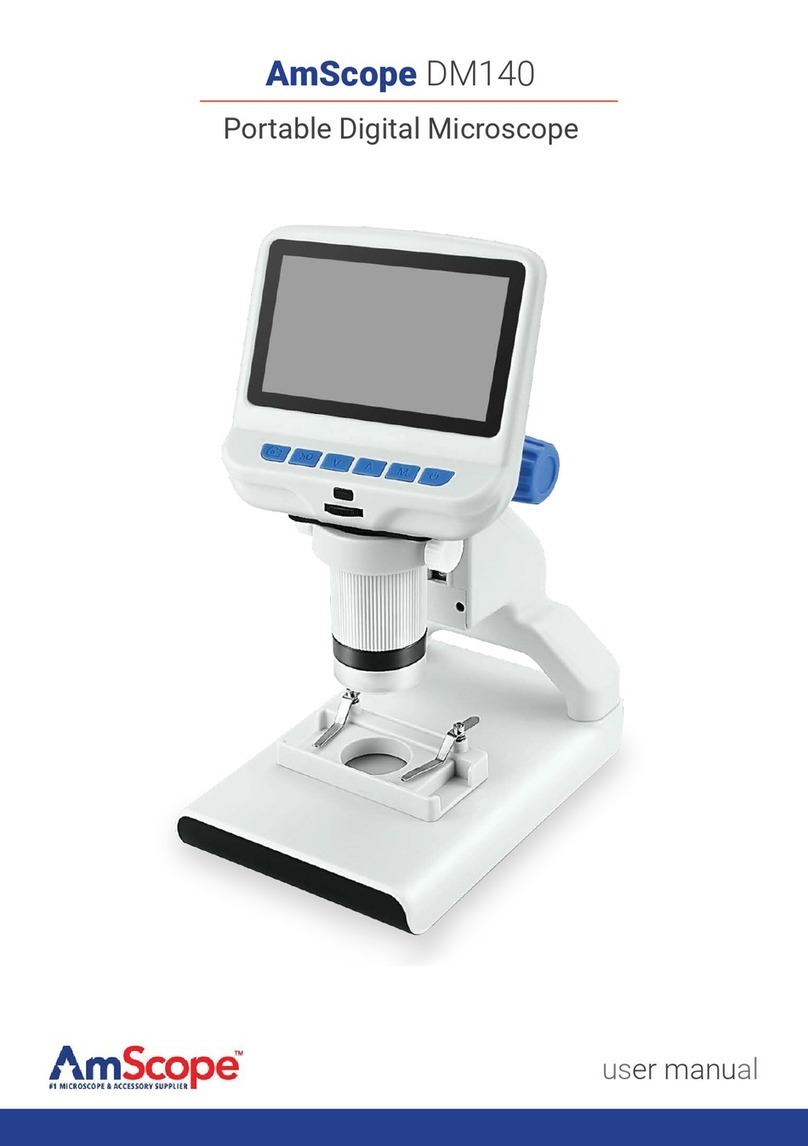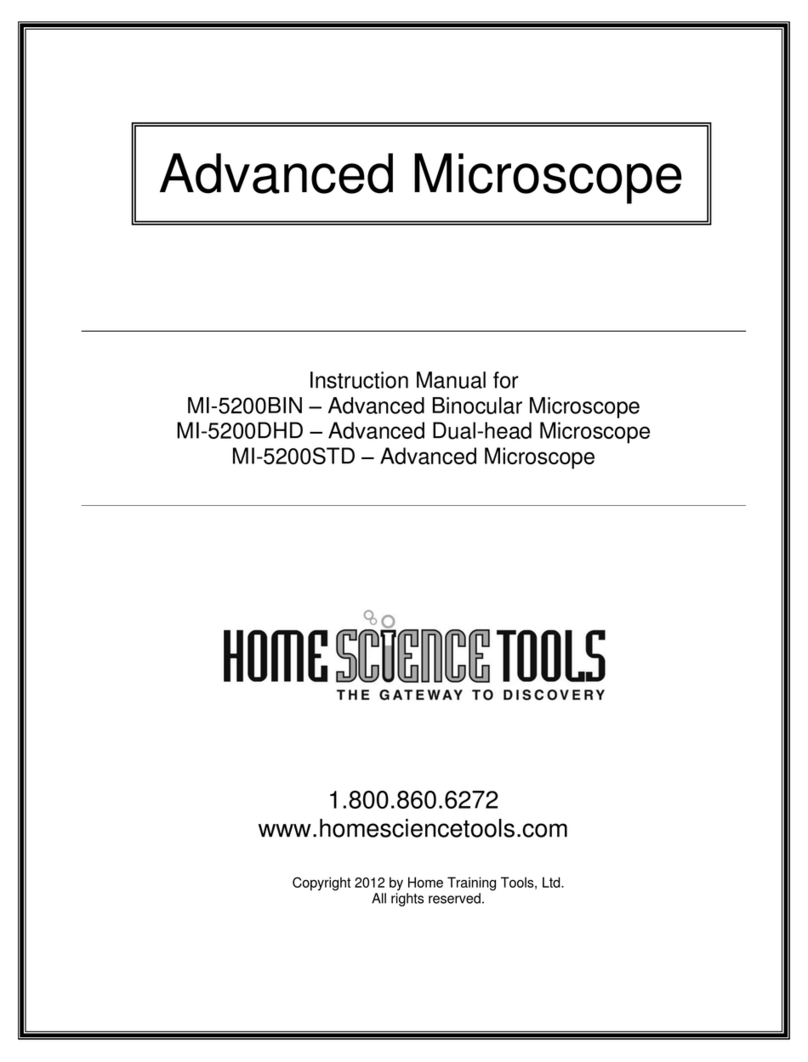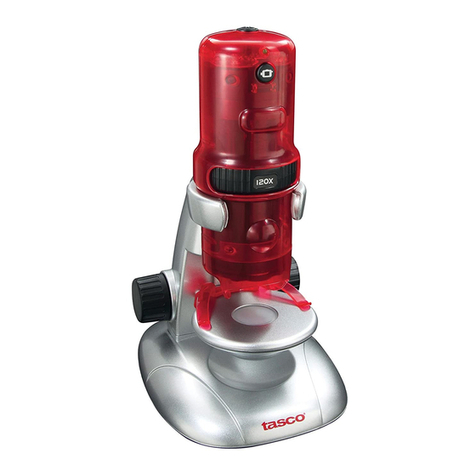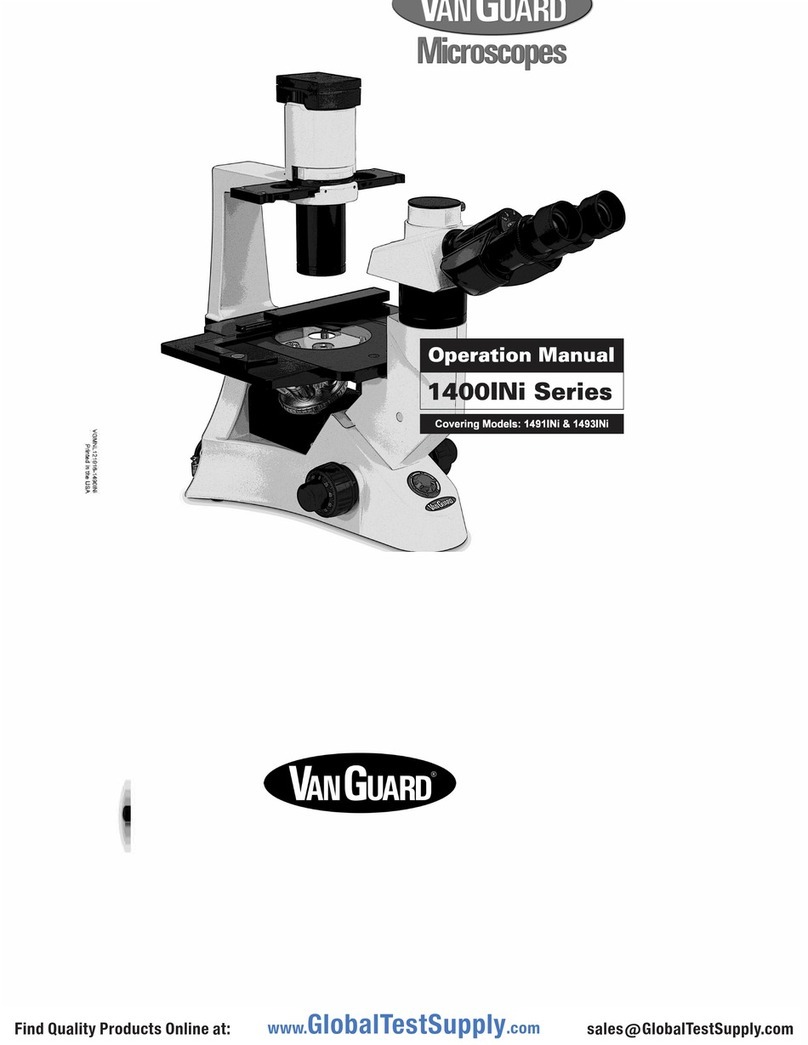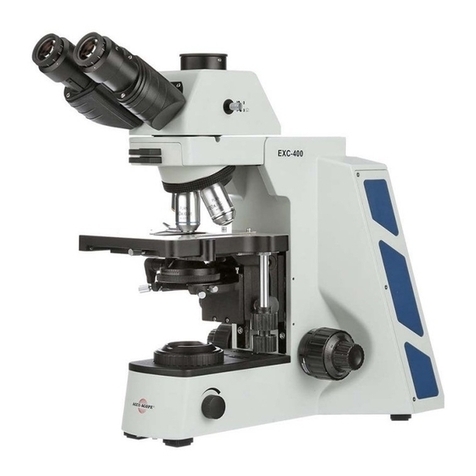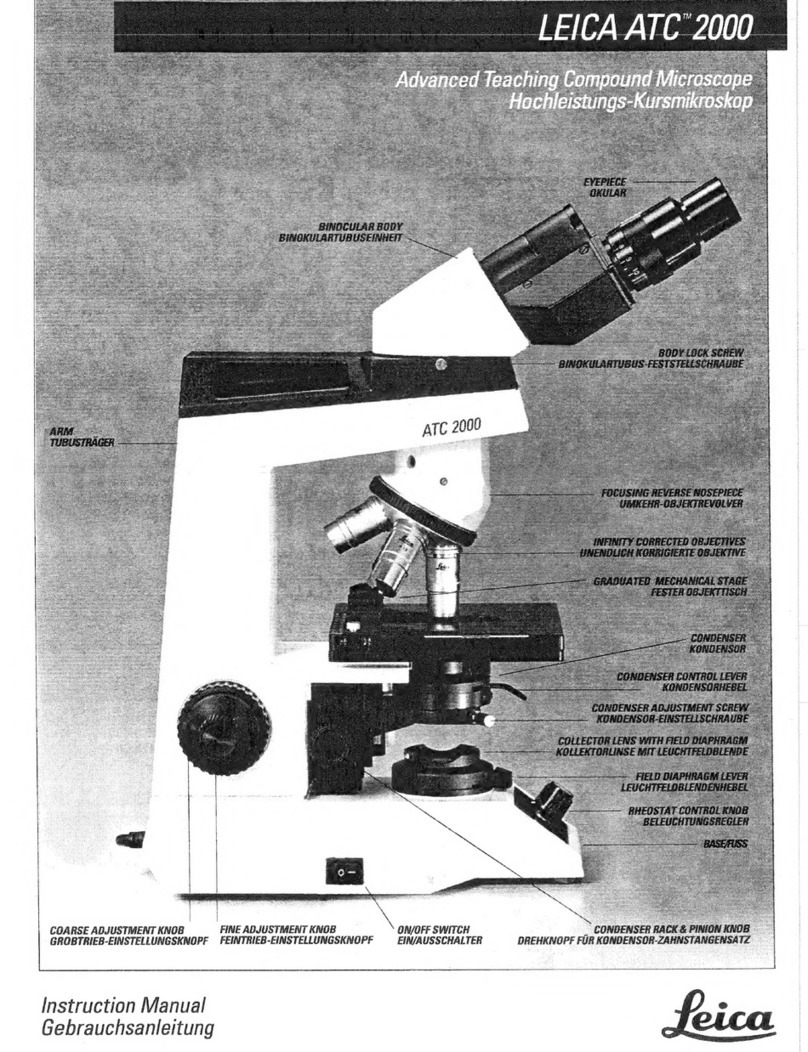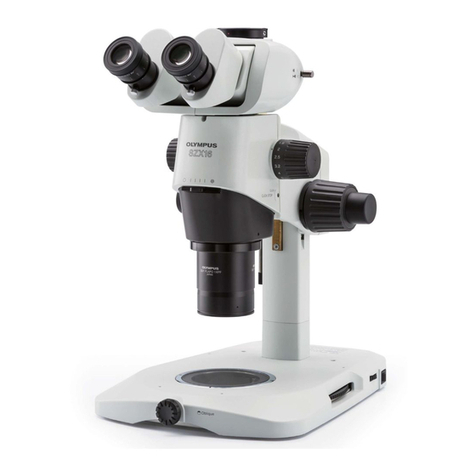Denville Scientific M3100 Series User manual

1
M3100 SERIES
MICROSCOPE
OPERATION MANUAL
Denville Scientific, Inc.
P.O. Box 4588, Metuchen, NJ 08840-4588; USA
www.denvillescientific.com
Tel: 800-453-0385/ 908-757-7577 Fax: 908-757-7551
Contents
Safety, General Information ……………….…………………………………………………………………..……… 3

2
1. Before Use …………………………………………………………………………………………………………. 4
1.1 Notice …………………………………………………………………………………………………………… 4
1.2 Maintenance ………………………………………………………………………………………………… 5
1.3 Power Requirement and Fuse ………………………………………………………………………. 5
2. Unpack and Assemble the Microscope ………………………………………………………………. 6
2.1 Unpacking ……………………………………………………………………………………………………. 6
2.2 Assembly ……………………………………………………………………………………………………… 6
3. Operation …………………………………………………………………………………………………………. 7
3.A Install and Set the Condenser …………………………………………………………………….. 7
3.1 Illumination and Adjustments …………………………………………………………………….. 8
3.2 Slide Holder ………………………………………………………………………………………………… 9
3.3 Focusing and Diopter Adjustment ………………………………………………………………. 9
3.4 Focusing Tension Adjustment …………………………………………………………………….. 10
3.5 Interpupillary Distance Adjustment ……………………………………………………………. 10
3.6 Centering the Condenser ……………………………………………………………………………. 11
3.7 The Field Diaphragm (Koehler) Setting ………………………………………………………. 12
3.8 The Condenser Iris Diaphragm Setting ………………………….…………………………… 12
3.9 Use 100X Oil Immersion Objective …………………………………………………………….. 13
3.10 Correct Filter Use …………………………………………………………………………………….. 14
3.11 Using the Trinocular Head for Video/Photography …………………….………….. 14
4. Replacing the Fuse …………………………………………………………………………………………… 15
5. Replacing the LED Assembly ……………………………………………………………………………. 16
6. General Specifications ………………………………………………………………………………………. 16
7. Trouble Shooting ………………………………………………………………………………………………. 18
8. M3100 Microscope Diagram ……………………………………………………………………………….. 21
DENVILLE SCIENTIFIC M3100 Series Microscope

3
We thank you for choosing the Denville Scientific M3100 Series Microscope. This precisely built, durable microscope
should give you years of service to even the busiest office practice. Our technical and customer support departments
stand ready to assist you with any questions or comments you may have. Please read this manual carefully before you
operate the microscope.
Warning: The microscope must be used in a manner as specified in this manual or the overall safety may be impaired.
If ever you require an additional accessory or spare part, please contact your local distributor, or you can contact
DENVILLE SCIENTIFIC for the name of the nearest distributor.
Safety, General Information
The microscope described in this manual is designed to be used by properly trained personnel in a suitably equipped
laboratory. For the correct and safe use of this microscope it is essential that laboratory personnel follow generally
accepted safe procedures in addition to the safety precautions called for in this manual.
The inside of the illumination base is a hazardous area and the cover should not be removed. ANY Servicing must be
done by an authorized technician.
Please carefully read the Safety, Electrical, Warning, Performance instructions below.
Safety
This microscope has been designed and tested in accordance with EN 61010 Safety Requirements for Electrical
Equipment for Measurement, Control, and Laboratory Use. This microscope has been supplied in a safe condition.
Read the following before installing and using the instrument and its accessories.
Electrical
Before switching on the microscope, make sure it is set to the voltage of the local power supply (see Installation). The
M3100 Series features a broad range power system, 90 –240 Volts.
The main plug shall be inserted in a socket provided with a protective earth (grounded) contact. The protective action
must not be negated by the use of an extension cord without a protective conductor.
Warning
Any interruption of the protective conductor inside or outside the microscope or disconnection of the protective earth
terminal is likely to make the microscope dangerous. Intentional interruption is prohibited. Whenever it is likely that
the protection has been impaired, the microscope shall be made inoperative and be secured against any unintended
operation.
The protection is likely to be impaired if, for example, the apparatus or power cord

4
Shows visible damage
Fails to perform the intended measurements
Has been subjected to prolonged storage under unfavorable conditions
Has been subjected to rough or severe transport
Safety Signs and Symbols
Proper labels and symbols are used to supply important information for safety and performance. The operating
personnel must fully understand the meanings of those labels and symbols before operating the microscope.
Read the manual before using. Faulty operation could lead to injury or instrument malfunction.
|
Power switch ON
O
Power switch OFF
The optimum environment: Temperature 5 –35 ℃
Humidity 80 %
1. Before Use
1.1 Notice
1.1.1 As the microscope is a precision instrument, always operate it with care, on a clean and dry, non-vibrating surface.
1.1.2 Do not operate in direct sunlight, or in the high temperature, damp, or dusty environments.
1.1.3 When moving the microscope always use both hands to hold ①and ②as shown in Figure 1, and set it down
with care. ★If holding the focusing knob, eyepiece tube or stage during moving, you may cause damage.
1.1.4 During operation, the field condenser ③may become warm/hot. Please make sure enough space around the
field condenser for cooling ( Figure 2).
1.1.5 Connect the microscope to power supply outlet with proper earthed ground to avoid electric shock.
1.1.6 The M3100 microscope has LED illumination system and bulb replacement is not necessary. In case the LED does
need to be replaced, make sure the power switch ④is set at“0”(off) and disconnect the power cord and wait until
the LED cools down before replacing the LED or the LED illuminator.

5
1.1.7 The power input voltage is 90~240V. Make sure the voltage supply is within this range.
Figure 1
Figure 2
Figure 3
1.2Maintenance
1.2.1 Wipe the lenses gently with a soft lens tissue. Carefully wipe off oil or finger prints on the lens surfaces with lens
paper or tissue. If the oil is dried on objective lenses it may be difficult to remove. Please use tissue moistened an optical
cleaning solution designed for “Coated” optics. Beginning in the center of the lens or eyepiece, rub the lens in an ever-
widening circle, until you reach the outer edge of the lens, or eyepiece surface. This is the best way to remove dust, dirt,
or oil and move it off to the side, or onto the moistened lens tissue.
1.2.2 Do not use an organic solution/solvent to attempt to clean the surfaces or other microscope components.
1.2.3 In the event liquid is spilled on the microscope damped by liquid, unplug the instrument immediately and wipe it
dry, then allow at least 24 hours for the unit to dry thoroughly before plugging it in again.
1.2.4 If you must disassemble the microscope yourself, unplug it first and exercise caution.
1.2.5 When the microscope is not in use, please cover the microscope with a dust cover.
1.3. Electronics and Fuse
Your Denville Scientific M3100 microscope uses U/L and CSA approved electrical components. There are no user
repairable parts in the illumination base. Any service here must be done by authorized Denville Scientific service
personnel.
Input: AC 90-240V/50-60Hz.
Output: 4.5V for LED
Warning: In order to avoid potential electrical hazard, replace only with the same type and rated LED.

6
Fuse: 250V 1A fuse is used to protect the illuminator from electrical overload. The two fuse cases are located near the
power inlet one the back of the microscope. When replacing the fuse, always unplug the instrument first then install a
new one of the same size and amperage.
Warning: In order to avoid electrical hazard, replace only with the same type and rated fuse.
2. Unpack and Assemble the Microscope
2.1 Unpacking your Denville Scientific M3100 Series Microscope
Each Denville Scientific microscope has been packed with utmost care. Please take a moment to examine the outer and
inner cartons for any visual damage. We recommend that you keep all of the packing material until you have fully
assembled, examined and tested your new microscope. If you note any damage, please contact the shipping company or
your distributor immediately as there are time limits on making freight damage claims.
Unpack your M3100 microscope using the following checklist for the parts and accessories. (Model M3127 is used as an
example. Your specific order may vary)
1M3100 Microscope stand
1 Condenser
1 Binocular head
2 10x eyepieces
4 Achromatic objectives 4x, 10x, 40xr and 100xr (oil)
2 Replacement fuses (250V 1A slow blow)
1 Each Blue filter; Dust cover and Operation Manual
If any parts are missing, please call Denville Scientific customer service at 800-453-0385 or e-mail us at
info@DenvilleScientificsci.com. Please be ready with the serial #, date of purchase and name of supplier.
2. 2 Assembly of your new M3100 Series microscope
Remove the microscope from the packing and place it on a sturdy, clean and dry surface. Do not touch optics or lenses
with your bare hands. The following illustrated figure will help you get familiar with the components that are required to
be installed on site.

7
Fig. 4 M3100 and Components
1. Condenser
2. Objective
3. Illuminator
4. Eyepiece
5. Power cord
2.2.1 Install and Set the Condenser
1.) Turn the coarse focus knob (① in Figure 5) to raise the stage to its highest position.
2) Turn the condenser holder knob (②in Figure 5) to lower the condenser holder to its lowest position.
3) Loosen the condenser locking screw on the holder (③in Figure 5). Slide the condenser into the holder. The guiding
screw on the back side should go into the slot of the condenser holder.
4) Tighten the locking screw ③to secure the condenser in place. Use the condenser holder knob ②to move the
condenser up to the highest position.

8
Fig. 5 Install Condenser
2.2.2 Install the Objectives (some models come with Objectives pre-installed)
1) Turn the coarse knob (① in Figure 6) to lower the stage for easy access to the nosepiece.
2) Install the objectives (②in Figure 6) from lower power (magnification) to higher power clockwise.
★Note: Lower power objective (such as 4X or 10X) is usually used first to locate the image.
★Note: The nosepiece will make a click to indicate an objective is properly positioned.
Fig.6 Install Objectives
2.2.3 Install Eyepieces

9
Remove the plastic caps from the eyepiece tube holes. Please make sure to keep dust and dirt from getting into the
eyepiece tubes. Store caps in a proper place. Slide the eyepieces into place in the eyepiece tubes.
Plug in the power cord into the power inlet at the back of the microscope to finish the assembly.
3. Operation
3.1 Illumination and Adjustment
Set the power switch ①at “ON”; and use the illumination rheostat knob ②to adjust the brightness.
Fig. 7 Illumination and Adjustment
3.2 Slide Holder
Put a slide ②on the mechanical stage and hold the slide with the slide holder. Make sure the cover glass is on
top of the slide. Using the mechanical stage controls ③, center the specimen on the slide under an objective.
Fig. 8 Slide Holder
3.3 Focusing and Diopter Adjustment

10
3.3.1 Set the 4X objective into light path. Turn the nosepiece to switch objectives. Use the coarse adjust to bring 4X into
focus. You may choose to rotate the nosepiece clockwise to bring the 10X into the light path.
3.3.2 Rotate the diopter rings ①(Fig.9) on both the left and right eyepiece tubes so that the “0” on the diopter ring is
set at the center line mark ②on the eyepiece tubes.
Fig. 9 Diopter and Setting
3.3.3 Using your right eye to view the slide; using the focus controls on the microscope turn the coarse focusing knob ①
(Fig.10) and then the fine focusing knob ②to bring the slide specimen into sharp focus through that eyepiece.
Fig.10 Coarse and Fine Focusing
3.3.4 Next, view the slide with the left eyepiece. Adjust the left diopter until the image is sharp, clear and in focus (do
not use the coarse and fine focus controls). You should now be in sharp focus with both your right and left eyes.
★Diopter adjustment range is ±5.
★You may want to remember your own diopter setting for future use.

11
3.3.5 Rotate the nosepiece to bring a higher power objective into light path. Use fine focusing adjustment knob to bring
the image into focus. (Note: 100X is an oil immersion objective and requires immersion when use).
3.4 Focusing Tension Adjustment
The focusing tension adjustment ring is located on the right side between the stand and the coarse focusing knob.
If one of the following conditions exists:
1)The coarse adjustment is difficult to turn, too tight or uncomfortable to use
2)The image drops out of focal plane after focusing
3)The stage slowly sinks down on its own, without touching the focus controls
Please use the tension adjustment ring ①(Fig. 13) to adjust. Turn it clockwise will tight the tension. Turn it
counterclockwise to loosen the tension.
Fig.11 Focusing Tension Adjustment
3.5Interpupillary Distance Adjustment
Once you are comfortably seated, look into the eyepieces (oculars) and move the eyepiece tubes together or
apart until you see only one complete circle of light. You have now adjusted your interpupillary distance.
The interpupillary distance adjustable range is 50-76mm. ★You may want to take a note of the your own
interpupillary distance setting for future use.

12
Fig. 12 Interpupillary Distance Adjustment
3.6 Centering the Condenser
1) Turn the condenser movement knob ①(Figure 13) to bring the condenser to the highest position.
2) Next turn the 10X objective into light path.
3) Next turn the field diaphragm ring (②in Figure 13) counterclockwise to close the diaphragm. At this time,
you should see the image (light-spot) of the diaphragm in the field.
4) Adjust the condenser movement knob ① until the diaphragm image becomes clear.
5) If the light spot appears off center; this indicates the condenser off-centered. Use the condenser centering
screws (③in Figure 13) to adjust the condenser position until the diaphragm image is centered. (Figure 14)
Fig. 13 Centering the Condenser
6) Open the field diaphragm slowly. If the diaphragm image circle is always at center in the view of field, then

13
the condenser has been properly centered.
Fig.14 Field Diaphragm
3.7 The Field Diaphragm (Koehler) Setting
The field diaphragm (Koehler Iris) can restrict the light coming from the illuminator to the condenser. This will
help to block the scatting of light and improve contrast. This setting is especially helpful when viewing unstained
specimens, or using Phase Contrast.
3.8 Setting the Iris Diaphragm in the Condenser
1) The Iris diaphragm in the condenser controls and determines aperture of the illumination to the objectives.
Only when the aperture of the illumination is properly set for an objective, can you get the best resolution and
contrast of the image; and the depth of field. The Iris is graduated to match the objective being used,
4/10/40/100X & Ph (phase).
Fig.15 Objective Aperture and Aperture Diaphragm

14
Note: The diaphragm aperture ①(Fig. 15) of the condenser is set at 70-80% of objective aperture ②(Fig. 15) for
best result. If necessary, take off the eyepiece and observe through eyepiece tube.
2) Because the contrast of the most slide specimens is very low, it is important to set the Iris diaphragm
properly for each objective. Slide the Iris setting lever ④to match the power of the objective in use.
Fig. 16 Iris Diaphragm Setting
3.9 Use the 100X OIL Immersion Objective
100X objective is designed to be used exclusively with immersion oil. Using oil prevents damage to both the slide
and objective, and improves amount light.
1) Start by using the 4X objective to find an image.
2) Place one drop of immersion oil ①on the specimen slide, in the path of the objective.
3) Turn the nosepiece COUNTER-CLOCKWISE and bring the objective 100X into light path. Use the fine focusing
knob to bring the image into focus.
★Make sure there are no bubbles inside oil as they will affect image quality. Follow the procedures below to
check and reduce the effects of bubbles:
A. Take off the eyepiece, open the Koehler field diaphragm and Iris diaphragm; then observe through eyepiece
tube to check for bubbles. If the edge of the objective is round and bright, then no bubbles are present.
B. Rotate the nosepiece back and forth softly to allow the 100X objective lens to swing through the oil to
smooth out the bubble.
4) After use, please clean the objective immediately, to avoid oil becoming dried on, and impairing viewing.
Also please wipe off the oil on the specimen slide.
★VERY IMPORTANT: Do not turn 40X objective into the light path before wiping off oil on the slide. 40X
objective is a dry objective and immersion oil will make 40X image blurry, and un-useable!

15
Fig. 17 Apply Immersion Oil on Slide for 100X
3.10 Use the Correct Filter
The right filter can make the background of the image more suitable for observation, depending on the specimen. There
are blue, green, yellow and neutral filters available. Select the proper filter for your specific application.
Fig. 18 Filter and Positioning
3.11 Trinocular use for Video/Photography: An 80/20 beam splitter is built-into the Trinocular head.
When the slide lever ①is pushed in, 100% of the light beam enters the eyepieces tubes and it functions as a Binocular
head. When the lever ①is pulled out, the light beam is split with 80% to the binocular and 20% to the vertical
tube/port for video and/or photographic purposes.

16
Fig. 19 Trinocular Head with Beam Splitter
Follow the steps below to setup for Digital, or S-Video Camera with C-mount
1) Loosen the locking-screw ①(Fig.20) on trinocular head and take off the cap ②on the vertical tube/port.
2) Remove the cap on the C-mount ③and put the adapter into the port and lock in-place with the screw.
3) The C-mount adapter’s top threaded mount ⑤is a standard external C-thread. Your video camera should
have an internal C-thread. Thread on your camera onto the C-mount adapter.
4) Loosen the locking screw ④to rotate your camera until the image is properly oriented. The C-mount adapter
includes an independent focusing ring; adjust for the best image.
Fig. 20 Setup for Video/Digital Camera

17
5) Push back the beam splitter slide lever ⑥when not using the vertical port for video/photography.
4. Replacing the Fuse
Turn the power switch to “OFF” and disconnect the power cord from power outlet before replacing the fuse.
Use a screw driver to remove the fuse cap①from the fuse base②(Fig.21) ;
Replace with new fuse(s) of the same type and rating;
Screw the fuse cap back. (Figure 24)
★Fuse Specification: 250V,1A.
Fig. 21 Fuse Replacement
5. Replacing the LED Assembly
The LED usually has a very long lifetime. Should it need to be replaced please follow the steps below to replace the
entire LED assembly.
1) Disconnect the power cord; Allow the unit to cool down.
2) Loosen the 4 locking screws that mount the bottom plate to the main base.
3) The LED assembly is mounted on the bottom plate with a two-wire cable to the power supply PCB. Disconnect
the connector from the power supply PCB. Then remove the LED assembly by loosening the two locking screws.
4) Install a new LED assembly onto the bottom plate and re-plug the connector to the power supply PCB.
5) Put the bottom plate back and lock in place with the screws.

18
6. Specifications
6.1 M3100 General Specifications
Optical system Color corrected optical system
Head(s) Binocular or Camera-ready Trinocular head, 30°inclined, 360°rotatable, Trinocular with 80/20 beam
splitter
Eyepieces High point plan eyepieces, FN 18mm, with rubber eye-guards
Nosepiece Built-in 5-hole nosepiece
Objectives High contrast achromatic objective (4X, 10X, 40X, 100X),
Plan achromatic objective (4X, 10X, 40X, 100X) or Plan Phase objectives available
Focusing Coaxial coarse and fine focusing with movement range up to 28mm and resolution at 0.002mm
Stage Built-in Mechanical stage 140 x132mm; with movement range 76*50mm and low X-Y adjustment knobs
Illumination LED illumination, 3 Watt with 90~240V wide range power supply.
Operation environment:
●For indoor use
●Altitude: below 2000m (under 7,000 ft. is optimal)
●Surrounding temperature: 5℃-35℃(41℉-95℉)
●Humidity: 80% humidity for 35 ℃(95 ℉);
6.2 Objective Specifications
Magnification
Numerical
Aperture (N.A.)
Conjugate
Distance (mm)
Par-focus Distance
(mm)
Cover Glass
(mm)
Ring Color
Achromatic 4X
0.10
195
45
0.17
Red
Achromatic 10X
0.25
195
45
0.17
Yellow

19
Achromatic 40X(S)
0.65
195
45
0.17
Blue
Achromatic 100X(0IL)
1.25
195
45
0.17
White
Plan Achromatic 4X
0.10
195
45
0.17
Red
Plan Achromatic 10X
0.25
195
45
0.17
Yellow
Plan Achromatic 40X(S)
0.65
195
45
0.17
Blue
Plan Achromatic 100X(OIL)
1.25
195
45
0.17
White
7. Trouble Shooting
Symptom
Cause
Remedy
1. Optics
1.1 Not bright enough
Field diaphragm is not open enough
Open the field diaphragm more
Condenser is too low
Adjust the condenser position
Condenser is not centered
Center the condenser
Beam splitter lever is pulled out
Push back the lever (trinocular only)
1.2 The edge of field of view is dark or
no even
Nosepiece is not at the right position
Turn the nosepiece to click into
position
Dust on lens (condenser, objective or
eyepiece
Clean the lens
1.3 Stain on the field of view
Stain on the specimen
Re-prepare the specimen
Stain on lens (condenser, objective or
eyepiece)
Clean the lens
1.4 Image blurry
No cover glass on the slide
Add cover glass (0.17mm)
The cover glass is too thick
Use 0.17mm thickness cover glass
Slide is upside down
Turn the slide, cover slip up

20
Oil on dry objective (i.e. 40X)
Clean the lens of the objective
No oil on the Oil objective (i.e. 100X)
Add immersion oil, see pg. 13
Bubble inside the immersion oil
See instructions on pg. 13
Wrong type of immersion oil
Use the right immersion oil
Iris diaphragm is not open properly
Adjust the Iris to get the best contrast
Stain or dust on lens (eyepiece etc)
Clean the lens
Condenser is too low
Adjust the condenser position
1.5 One side of the image is dark or
the image moves while focusing
The specimen is not stabilized
Stabilize the specimen
The nosepiece is not at the right
position
Turn the nosepiece to click into
position
Condenser is not centered
Center the condenser
The mechanical stage is not level
Check the stage, and table
1.6 Eyes get tired easily
Interpupillary is not set properly
Adjust the interpupillary distance
Diopter setting is not properly set
Set the diopter to fit your eyes
2. Mechanical
2.1 Unable to focus on higher
magnification objectives
Slide is upside down with cover glass
at the bottom
Turn the slide with cover slip on top u
Wrong cover glass is used
Use 0.17mm thickness cover glass
2.2 The objective touches slide while
turning from lower to higher power
objective
The slide is upside down
Turn the slide with the cover slip on
top
The cover glass is too thick
Use 0.17mm thickness cover glass
2.3 The coarse knob is too tight
The focusing tension setting is too
tight
Readjust the tension setting
2.4 The stage drifting down
The focusing tension setting is too
loose
Tight the focusing tension properly
Table of contents
Other Denville Scientific Microscope manuals

